

In the upcoming years, international students remain allured by the United States for its renowned education system and multifaceted cultural opportunities.
This article delves into the quality of life that international students can anticipate in the USA, offering valuable insights into diverse facets that shape their everyday experiences.
From accommodation choices to daily expenses, this comprehensive guide aims to present a clear understanding of the lifestyle that international students can enjoy while pursuing their education in the United States.
In this blog we will cover the following 16 topics:
As students around the world seek to carve their paths to success through higher education, the United States stands as an epicentre of academic excellence, housing renowned institutions that offer a diverse array of programs.
Just as the United Kingdom boasts its legacy of education, the US too presents a dynamic landscape that invites scholars from all corners of the globe.
In this comprehensive exploration, we delve into the realm of tuition fees at US universities, shedding light on the intricacies that define the cost of pursuing education in this land of opportunities.
The United States holds a special place in the hearts of those yearning for world-class education. With a rich tapestry of institutions ranging from Ivy League universities to cutting-edge research centres, students are welcomed into an environment that fosters intellectual curiosity and personal growth.
However, the privilege of education comes hand in hand with financial considerations, making it imperative to understand the nuances of tuition fees.
When it comes to evaluating the cost of education in the United States, several factors come into play. As with any investment, it's essential to weigh the benefits against the costs.
The tuition fees at US universities can vary significantly based on factors such as the institution's prestige, program of study, and the level of degree sought.
For an undergraduate program in the US, the average annual tuition for domestic students residing on campus can range from $10,000 to $40,000, depending on the university and the chosen field of study.
International students, while welcomed with open arms, may find themselves looking at a higher tuition bracket, with fees varying from $20,000 to $50,000 or more.
The diversity of academic pursuits in the United States is mirrored in the spectrum of tuition fees that different disciplines command.
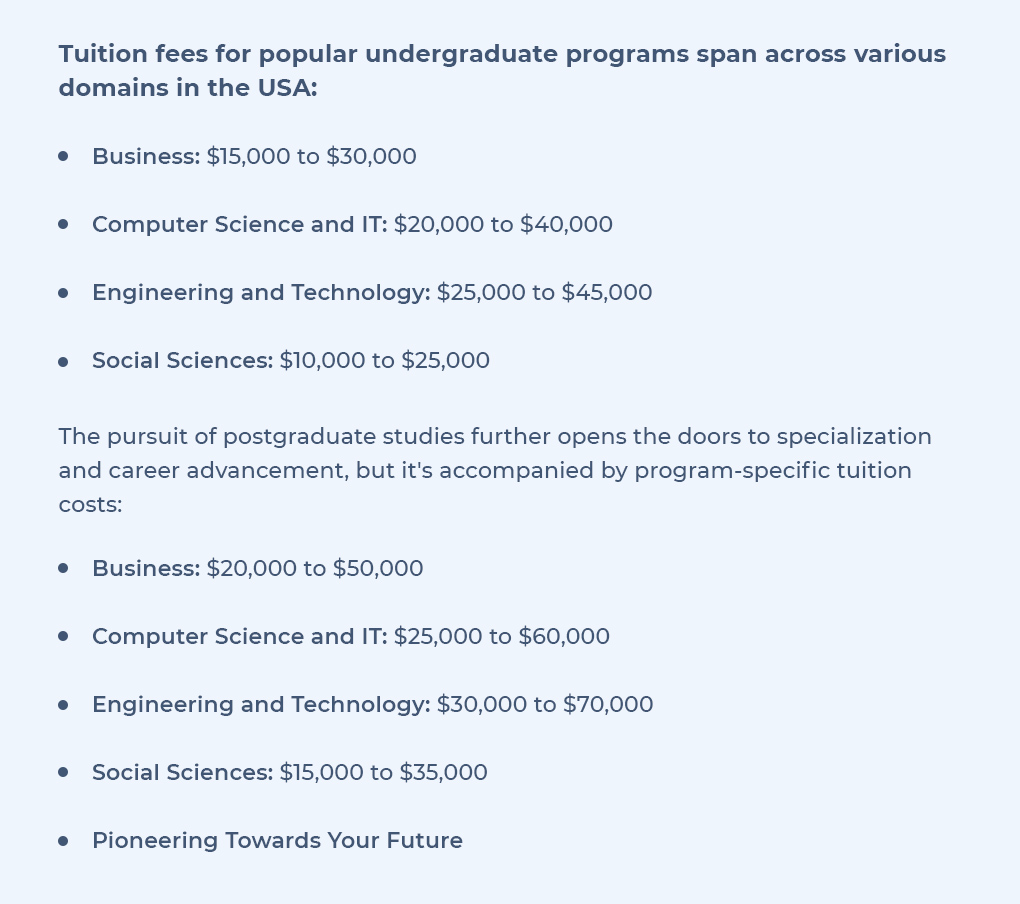
In the grand tapestry of education, the United States offers an array of institutions that beckon ambitious minds seeking holistic growth. While tuition fees are a vital consideration, they do not overshadow the array of opportunities that await within the campuses of American universities.
The investment in education extends beyond the financial aspect, encompassing personal and intellectual growth that becomes a lifelong asset.
As prospective students navigate the intricate path of higher education in the United States, it's crucial to factor in not just the tuition fees but also the array of scholarships, grants, and financial aid options that institutions offer.
Understanding the cost landscape equips students with the knowledge to make well-informed decisions that align with their aspirations, values, and financial considerations.
There are several types of housing options available for international students in the USA, each with its associated costs and features.
On-campus housing, commonly referred to as university dormitories or residence halls, is a popular choice for many international students in the USA. These accommodations are typically located within the university campus or nearby, providing easy access to classes and campus facilities.
Cost: The cost of on-campus housing can vary based on factors such as the university's location, room size, and amenities provided. On average, students can expect to pay around $150 to $600 per week. Rooms with private bathrooms or enhanced amenities tend to be at the higher end of the price range.
Private off-campus housing includes apartments, flats, or houses rented from private landlords. This option offers more independence and the opportunity to live away from the campus environment.
Cost: The cost of private off-campus housing varies significantly depending on the location and type of accommodation. In major cities like New York or Los Angeles, students might expect to pay approximately $1,000 to $2,500 per month for a one-bedroom apartment. Costs can be lower in smaller towns.
Homestays involve living with a local host family, providing international students with a chance to immerse themselves in American daily life and culture.
Cost:The cost of homestays varies based on factors such as location, included meals, and living conditions. On average, students can anticipate spending around $200 to $400 per week.
Short-term accommodation options include hostels, guesthouses, or serviced apartments. These are especially suitable for students who are arriving in the USA and require temporary housing until a more permanent solution is secured.
Cost:The cost of short-term accommodations varies, with hostels being the most budget-friendly option. Prices depend on the location and the level of amenities provided.
Many international students in the USA opt for shared housing or roommates to split the costs and create a sense of community within their living arrangements.
Cost:The cost of shared housing can vary based on location and the number of roommates. Rent and utilities are divided among the occupants, making it more affordable for each individual.
In summary, international students in the USA have a range of housing options, each with its own advantages and costs, allowing them to tailor their accommodation to their preferences and budget.

When considering the cost of living in the USA, managing your budget for food and groceries is a significant aspect for international students. The United States provides a diverse array of dining choices, ranging from cooking meals at home to dining out at various establishments. Let's delve into the specifics of food expenses and effective budget management strategies.
Opting to prepare your meals at home can prove to be a cost-efficient approach, allowing you to have control over your expenses and dietary preferences. Here's a breakdown of what you can anticipate:
Although cooking at home is cost-effective, indulging in dining out occasionally can be a delightful experience. Here's an overview of what to expect when eating out:
In the United States, managing your food budget effectively can involve a combination of home cooking and well-planned dining out experiences, allowing international students to strike a balance between satisfying their taste buds and being mindful of their expenses.

Navigating within the United States is a crucial consideration for international students. The country offers a diverse transportation network, encompassing public transit options and various travel modes. Familiarizing yourself with transportation costs and making informed decisions can assist in effective budget management.
The United States boasts an extensive public transportation system that includes buses, trains, subways, and light rail systems, depending on the city. Here's what you need to know:
Metro Cards (New York): If you're in New York City, the MetroCard is a convenient method for accessing public transportation, including the subway and buses. It often offers discounted fares compared to individual ticket purchases.
Fare Structure: Fare structures vary by city, with single rides costing around $2 to $3 on average. Many cities also offer daily, weekly, or monthly passes, which can provide better value if you plan to use public transit frequently.
Taxis and ride-sharing services like Uber and Lyft are prevalent in urban areas across the U.S. While convenient, they tend to be more expensive than public transportation.
Cost: Taxi and ride-sharing costs vary based on factors such as distance and demand. It's advisable to use them for specific occasions or when time is of the essence.
Bicycling is a popular and eco-friendly mode of transportation in many U.S. cities. Urban areas often have dedicated bike lanes and bike-sharing programs.
Cost: Cycling can be a cost-effective option if you own a bicycle. If not, you can consider purchasing a new or used bike or using a bike-sharing service, which typically charges around $1 to $2 for short rides.
Renting a car is a popular option, especially if you're planning trips outside the city or require greater mobility.
Cost: Car rental prices vary depending on factors like the type of car, rental duration, and location. On average, you might spend around $30 to $50 per day for a basic rental car.

When pursuing your education in the United States, finding a balance between academic commitments and leisure activities is essential. The USA offers a diverse range of cultural experiences and entertainment options for international students.
Here's a comprehensive guide to managing leisure expenses and making the most of your free time.
The United States is rich in history and culture, featuring a plethora of museums, galleries, and historical sites to explore. Many of these attractions offer discounted or free entry for students.
Cost: Entry fees vary depending on the attraction. Some museums and galleries offer free admission, while others may charge between $5 to $15 for student tickets.
Major cities across the USA boast vibrant performing arts scenes, with theatres hosting an array of productions, from Broadway shows to local performances.
Cost: Ticket prices vary depending on the production and seating. Student discounts are often available for theatre performances.
The USA is renowned for its diverse music and nightlife scenes. Live music venues and nightclubs can be found throughout the country, hosting concerts, gigs, and DJ nights.
Cost: Concert ticket prices vary widely based on the artist and venue. Some nightclubs may charge an entry fee, especially on weekends.
The United States offers stunning national parks and recreational areas, providing opportunities for leisurely walks, picnics, and outdoor activities.
Cost: Many parks have entry fees, but they can be modest. Some outdoor activities might have associated costs, such as renting sports equipment.
Most universities in the United States offer a diverse range of student clubs and organizations catering to various interests, including sports, hobbies, cultural pursuits, and academics.
Cost: Membership fees for student clubs and organizations are typically reasonable and grant access to social events and activities.
The mobile market in the USA is dominated by major network operators such as Verizon, AT&T, T-Mobile, and Sprint. Additionally, numerous Mobile Virtual Network Operators (MVNOs) like Boost Mobile and Cricket Wireless provide services using the networks of the primary operators.
Coverage: The USA boasts widespread mobile coverage, with strong 4G and 5G services available in most urban areas. Rural regions may have slightly reduced connectivity but generally maintain reasonable 3G or 4G coverage.
Cost: Basic pay-as-you-go (PAYG) plans, allowing credit top-ups as needed, can start from as low as $10. These plans often include a specific number of minutes, texts, and data. Contract plans, typically bundled with smartphones, may begin around $20 and increase based on the phone model and package features.
Internet Connectivity in the USA: The broadband landscape in the USA is as varied as its mobile services. Prominent providers include Comcast Xfinity, AT&T, and Spectrum.
Types of Broadband: The USA offers various broadband connections, including DSL, cable, and fibre optic, with fibre optic providing high-speed internet available in urban areas.
Cost: Standard broadband packages suitable for browsing and streaming can range from $30 to $70 per month. Fiber optic packages, offering ultra-fast speeds of up to 300 Mbps or more, typically range from $40 to $100 per month.
Many providers bundle internet packages with TV and phone services, offering discounted rates for combined services.
Installation: Setting up a new connection might involve an initial installation fee, which could be waived during promotional periods or for longer contract agreements.
Understanding the entertainment and leisure options available in the United States and their associated costs will help international students make the most of their recreational experiences while effectively managing their budgets.

Finding a balance between your studies and part-time work can be a valuable way to manage expenses and gain practical work experience while pursuing education in the United States.
Here's an inclusive guide to understanding the part-time work opportunities available for international students.
Many universities in the USA offer on-campus job opportunities specifically tailored for international students. These roles are designed to accommodate your academic schedule.
Types of On-Campus Jobs:
Work Hours: On-campus jobs typically allow up to 20 hours of work per week during the academic term and full-time hours during breaks..
Advantages:
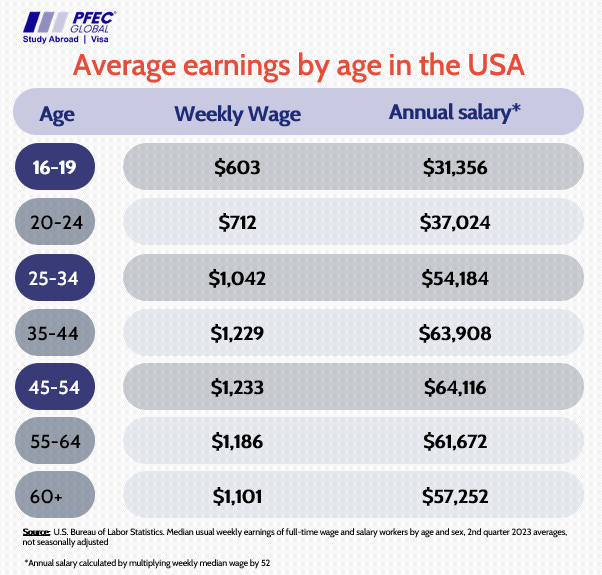
International students studying in the USA can explore off-campus job opportunities, usually after the first academic year, in accordance with visa regulations.
Types of Off-Campus Jobs:
Work Hours: Similar to on-campus jobs, off-campus employment usually permits up to 20 hours of work per week during the academic term and full-time hours during breaks.
Advantages:
Understanding the regulations around part-time work is essential for international students in the USA:
Work Hours: While studying, you're generally allowed to work up to 20 hours per week during the academic term and full-time during official breaks.
Minimum Wage: The USA has federal and state minimum wage laws that employers must adhere to. Make sure to research the current minimum wage rates in your location.
Social Security Number (SSN): To work legally in the USA, you'll need a Social Security Number (SSN). You can apply for one upon arrival and once you have a job offer.
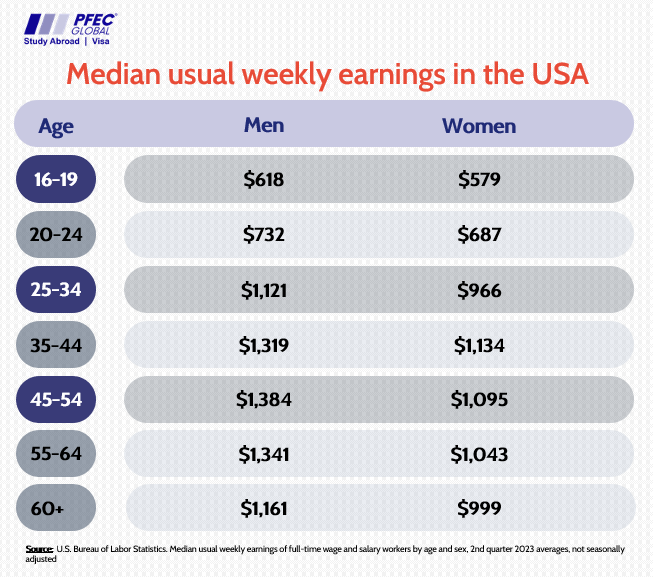
Maintaining equilibrium between your work commitments and academic responsibilities is crucial:
Understanding the diverse part-time work opportunities available in the United States and adhering to relevant regulations will help international students make the most of their educational journey while gaining practical skills and financial stability.
The Optional Practical Training (OPT) program allows international students in the United States to stay and work for up to 12 months after completing their degree. STEM (Science, Technology, Engineering, and Mathematics) degree holders can extend their OPT period for an additional 24 months, promoting growth in these high-demand fields. Here's how to navigate the eligibility criteria and application process for post-study work opportunities in the USA:
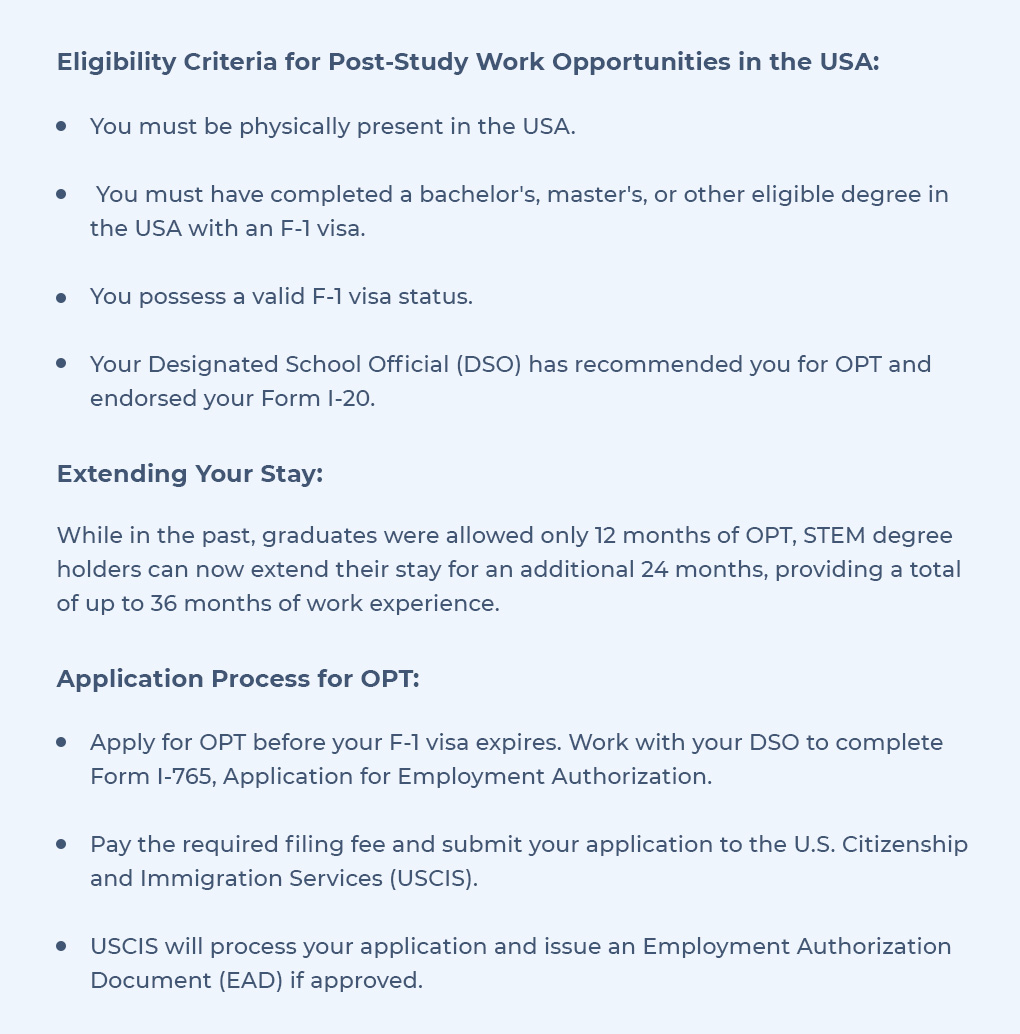
When it comes to international students planning their education in the USA, understanding the exchange rate and its influence on expenses is a crucial financial consideration, particularly when converting to US Dollars. Accurately gauging daily costs entails grasping the value of your home currency in USD.
Numerous exchange services and financial institutions may apply a markup to the exchange rate as a means to enhance their profit margins through currency conversion. Given this, prospective students are advised to deeply investigate both the most economical and relatively higher-cost cities across the USA. This approach ensures they gain a comprehensive understanding of potential living expenditures during their academic journey in the country.
Here are the five most expensive cities to reside in the USA:
However, if the high cost of living is enticing you to consider a new location, here are the five most affordable cities in the USA:
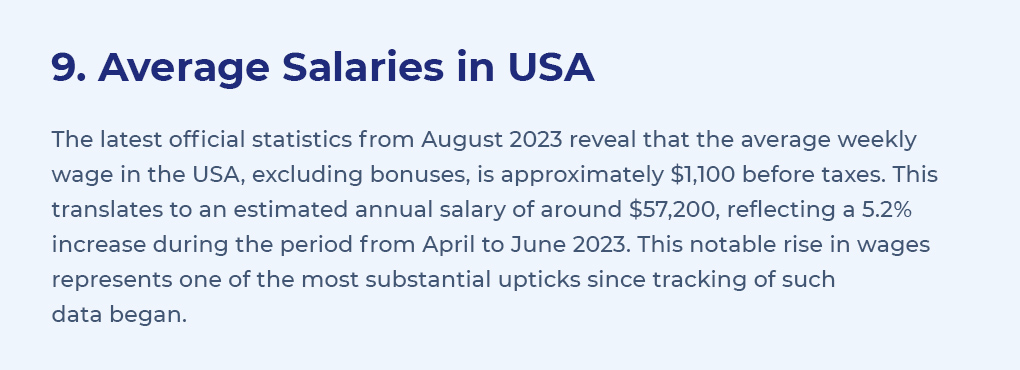
Interestingly, the median compensation for top CEOs, primarily from companies listed in the S&P 500, surged to a staggering $12.7 million in 2022, signifying a 14% annual increase.
This statistic, reported by various sources including the Economic Policy Institute, highlights that such earnings are approximately 231 times the average salary of a typical American worker.
For a more detailed analysis of the earnings of ordinary workers, the U.S. Bureau of Labor Statistics (BLS) regularly publishes the Current Population Survey and Occupational Employment Statistics reports.
These reports offer valuable insights into wage distributions and trends across the nation, providing a more nuanced perspective on income disparities and earning patterns.
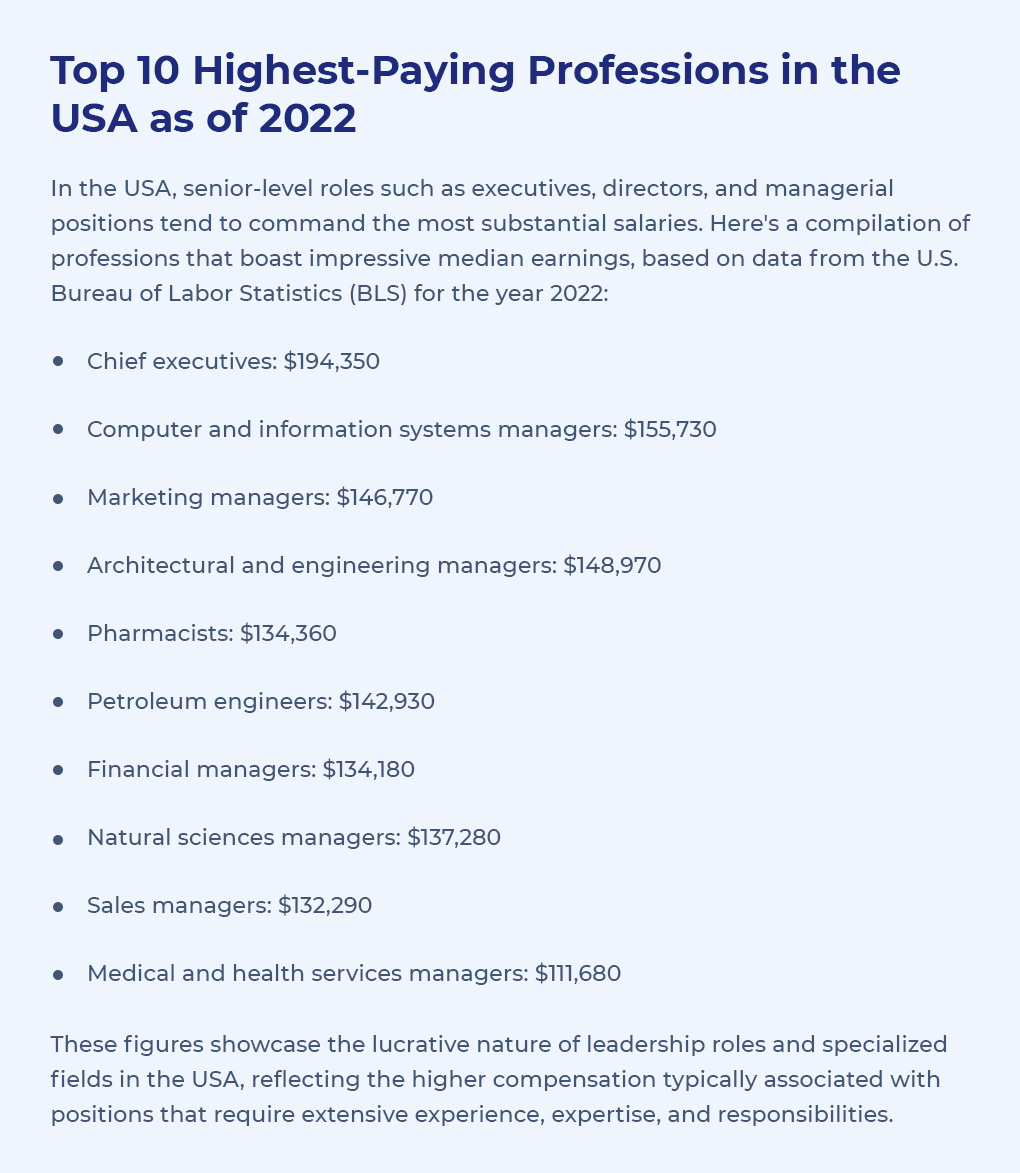
Securing access to quality health care is a crucial consideration for international students studying in the USA. The country offers a diverse health care system, and comprehending health care options and insurance requirements can help you maintain your well-being and financial stability during your studies abroad.
Unlike some countries with a publicly funded health care system, the United States does not have a universal health care system. Health insurance is typically required for international students, and many universities mandate that students have health coverage to enrol.
Access to Health Insurance: Most universities offer health insurance plans specifically designed for international students. These plans usually cover a range of medical services and treatments, both on and off campus.
Advantages:In addition to university-provided plans, some international students opt for additional private health insurance coverage to supplement their existing plans or ensure broader coverage.
Advantages:
Cost: Private health insurance costs can vary widely based on coverage options, the insurance provider, and the state you're studying in.
Prescription medications are not always fully covered by health insurance plans. Depending on your plan, you might need to pay a portion of the cost for each prescribed medication.
Cost: Prescription costs can vary widely based on the medication and insurance plan. Generic medications are usually more affordable than brand-name ones.
To access medical care, it's advisable to locate a nearby health care provider or medical clinic. Many universities have health centres on campus, which can be a convenient option for minor health concerns.
Advantages:
In case of emergencies, you can seek medical treatment at hospital emergency departments. Emergency treatment is available regardless of whether you have health insurance, but it's important to have coverage to manage potential costs.

Pursuing education in the USA not only offers academic excellence but also provides a vibrant cultural and social experience. Engaging in cultural activities, participating in social events, and immersing yourself in the local community can contribute to a fulfilling student life.
Here's a comprehensive guide to managing your cultural and social expenses while enjoying your time in the USA.
The USA is renowned for its diverse and inclusive society, offering a blend of cultures and perspectives. Embracing this multicultural environment can enrich your personal growth and expand your horizons.
Cost: Engaging with different cultures and communities is often free or involves nominal expenses for attending events, workshops, or activities.
American universities offer an array of student organizations and clubs that cater to a wide range of interests. Joining these groups is an excellent way to connect with peers who share similar passions.
Cost: Membership fees for student organizations and clubs vary, but they are generally affordable. These fees contribute to organizing events, workshops, and social activities.
The USA hosts countless local events, festivals, and celebrations year-round. Participating in these cultural gatherings can offer insights into local traditions and customs.
Cost: Entry to many local events and festivals is often free or requires a small fee. Larger or international events might have higher ticket prices.
The USA boasts world-class museums and cultural sites that delve into art, history, and heritage. Many institutions offer discounted or free entry for students.
Cost: Museum and cultural site entry fees can vary. Some locations provide free entry, while others might charge an admission fee ranging from a few dollars to around $15 for students.
Connecting with friends and peers often involves dining out or gathering at cafes. Exploring local cuisines and trying different restaurants can be a delightful social experience.
Cost: The cost of socializing and dining out can vary widely based on the venue and preferences. Budget around $10 to $20 for a casual meal or outing.
The USA offers a thriving arts and entertainment scene, including theatre productions, concerts, and performances. Attending these events can offer a glimpse into the country's creative culture.
Cost: Ticket prices for arts and performances can vary widely based on the event and location. Student discounts are often available, offering more affordable access to cultural experiences.
Embracing the cultural and social opportunities in the USA can enhance your overall student experience. Be sure to explore the diverse range of activities and events available to make the most of your time abroad.

As an international student pursuing education in the United States, you'll immerse yourself in a dynamic academic environment that fosters intellectual growth, independent thinking, and research excellence. This section offers a comprehensive exploration of the teaching methods and research opportunities that contribute to the enriching academic experience offered by US universities.
US universities are renowned for emphasizing critical thinking and active learning among students. The teaching styles employed in these institutions reflect a commitment to cultivating well-rounded and intellectually curious individuals.
Lectures play a pivotal role in the US higher education system. Professors deliver key concepts, theories, and ideas related to the course material. However, lectures are not solely about passive listening. Students are encouraged to actively engage with the content, ask questions, and participate in discussions.
Small group discussions and seminars provide platforms for in-depth exploration and analysis. Students are expected to participate actively, share their viewpoints, and engage in meaningful debates. These sessions foster critical thinking and encourage collaborative learning.
Workshops and laboratory sessions offer hands-on learning experiences. Students engage in practical applications of theoretical concepts, conduct experiments, and develop problem-solving skills. These sessions are particularly common in science, engineering, and technical disciplines.
US universities are globally recognized for their groundbreaking research contributions across various fields. International students have the unique opportunity to participate in cutting-edge research projects, contributing to their academic and professional growth.
Many US universities prioritize research collaboration between students and faculty members. This allows international students to actively engage in ongoing research projects, collaborate with experts in their field, and contribute to the advancement of knowledge.
Even at the undergraduate level, US universities encourage students to engage in research. Early exposure to research empowers students to explore their interests, develop critical research skills, and gain insights into research methodologies.
US universities offer well-equipped research facilities and extensive resources that create a conducive environment for students to explore diverse research areas. Access to state-of-the-art labs, libraries, and online databases enables comprehensive research.
Engaging in research activities not only enriches academic experiences but also enhances employability. Participation in research projects equips international students with problem-solving abilities, analytical thinking, and a profound understanding of their chosen fields – qualities highly sought after by employers.
The climate across the United States varies significantly due to its vast geographical expanse. Be prepared for diverse weather conditions and invest in appropriate clothing to stay comfortable throughout the year.
Some regions in the US experience extreme weather events such as hurricanes, tornadoes, and wildfires. It's crucial to stay informed and be prepared for such occurrences by following local authorities' guidance and having necessary supplies on hand. Additionally, individuals in regions with minimal sunlight during certain months should be aware of potential effects on mood and mental health, like Seasonal Affective Disorder (SAD), and take appropriate measures for self-care and support.
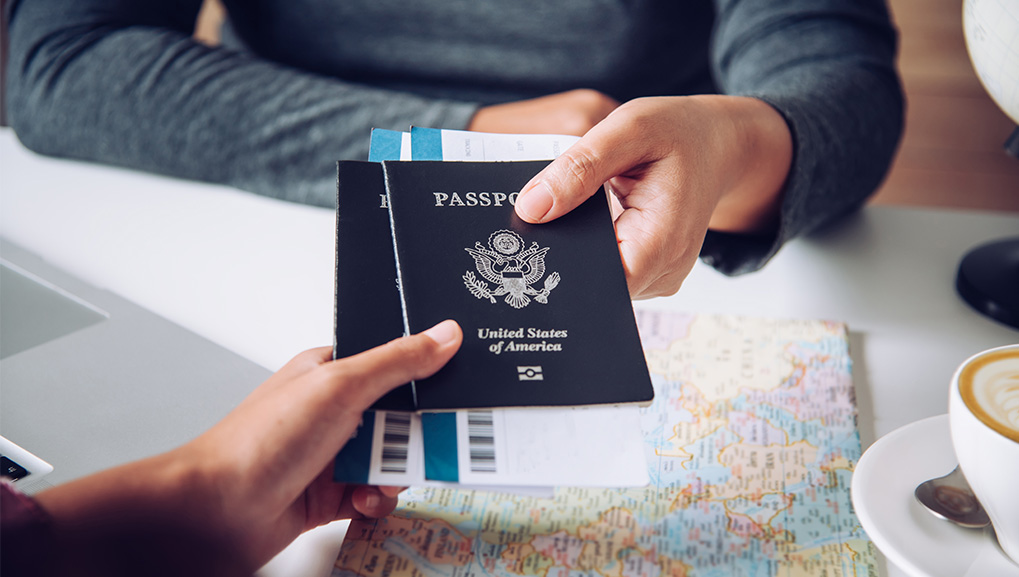
Comprehending visa regulations is paramount for international students planning to study in the United States. The U.S. government outlines various visa categories for students, scholars, and exchange visitors, each with specific requirements and permissions for entry and stay. The most common student visa is the F-1 visa, which allows individuals to pursue academic studies at accredited institutions. Alongside the F-1 visa, the J-1 visa is utilized for exchange programs, while the M-1 visa is tailored for vocational and non-academic programs. Understanding the visa application process, required documentation, financial obligations, and potential work permissions is essential for a smooth transition into U.S. academia. Additionally, staying informed about any updates or changes in visa regulations and maintaining legal status during your stay is crucial to ensure a successful and enriching educational experience in the USA.
For more compelling reasons read our blog: "A comprehensive Guide to Student Visa for USA: Types, Requirements, and Application Process".
The United States is generally considered safe for international students, but like any country, it's important to remain vigilant and practice common-sense safety measures. While the USA offers a wide range of safe environments, crime rates can vary significantly from one city or neighbourhood to another.
It's recommended to research the safety profile of your intended destination and be aware of local safety guidelines. Staying informed about emergency contacts, understanding local emergency procedures, and taking precautions such as securing your belongings and avoiding risky areas during late hours are key to ensuring your safety.
To know more, read our Blog: Safety and Security for International Students in the USA

When studying in the USA, effective financial management is essential. Opening a bank account in the US provides convenient access to your funds and simplifies financial tasks such as paying tuition, rent, and daily expenses.
In the US, digital banking is also on the rise. Online banks like Ally Bank, Chime, and Varo offer seamless digital experiences, high-interest savings accounts, and fee-free transactions.
By understanding US banking options and implementing smart financial practices, you can navigate your student life in the USA with financial confidence.
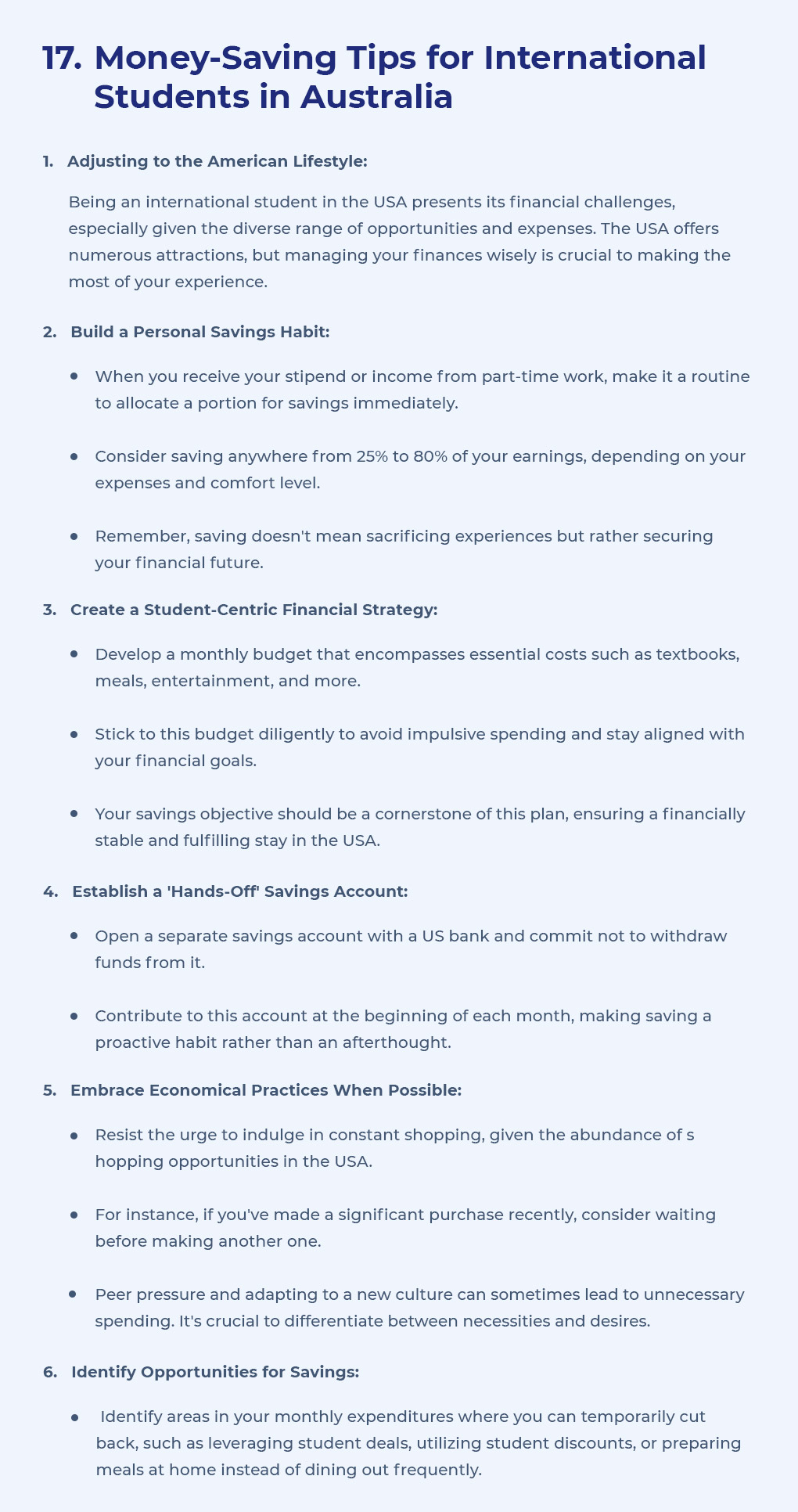
By adhering to prudent financial habits and smart spending strategies, international students can make the most of their time in the USA without compromising their financial stability.
In conclusion, being an international student in the USA provides a unique blend of educational enrichment, cultural diversity, and personal development. With strong academic institutions, ample opportunities for employment, and a lively social environment, the United States remains a sought-after destination for those striving for both academic excellence and an exceptional quality of life.
Embrace the journey, seize every opportunity, and let your time in the USA shape your academic and personal growth in unforgettable ways.

Studying abroad is an exciting and life-changing experience that offers students a chance to gain a global perspective and valuable exposure ...

In our rapidly globalizing world, where boundaries are melting away and opportunities abound, proficiency in the English language has become ...

Choosing to pursue higher education abroad is an exciting and life-changing decision. Among the plethora of options available to internationa...

Studying abroad is a life-altering adventure that opens doors to new cultures, experiences, and opportunities. Among the plethora of global s...

Australia, renowned for its world-class education and diverse cultural experiences, continues to be a favoured destination for international ...

Australia is not just famous for its iconic Sydney Opera House, the Great Barrier Reef, and its unique wildlife; it is also recognized global...

Studying abroad is a life-changing decision, and with so many options available, it can be overwhelming to choose the right country and univers...

As of March 2022, Australia has seen a consistent rise in its international student numbers, with enrolments reaching 440,219. This marks an ...